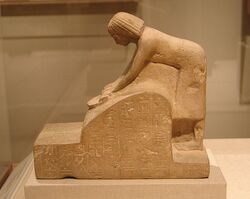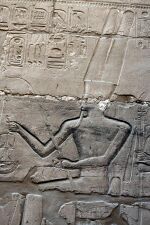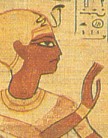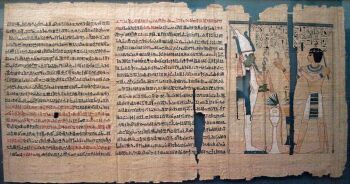High Priest of Amun
Topic: Religion
 From HandWiki - Reading time: 6 min
From HandWiki - Reading time: 6 min
| <hiero>R8 U36 T8 n i mn:n:N5</hiero> |
| style="background: Template:Hiero/nk/bgcolour; border-bottom: 1px solid Template:Hiero/nk/bordercolour; padding: 0.5em" | High Priest of Amun ḥm nṯr tpj n jmn in hieroglyphs |
|---|
The High Priest of Amun or First Prophet of Amun (ḥm nṯr tpj n jmn) was the highest-ranking priest in the priesthood of the ancient Egyptian god Amun.[1] The first high priests of Amun appear in the New Kingdom of Egypt, at the beginning of the Eighteenth Dynasty.
History
The priesthood of Amun rose in power during the early Eighteenth dynasty through significant tributes to the god Amun by rulers such as Hatshepsut and more importantly Thutmose III.[2] The Amun priesthood in Thebes had four high-ranking priests:[3]
- The Chief Prophet of Amun at Karnak (ḥm nṯr tpj n jmn), also referred to as the Chief Priest of Amun.
- The Second Prophet of Amun at Karnak (ḥm nṯr snnw n jmn), also referred to as the Second Priest of Amun.
- The Third Prophet of Amun at Karnak (ḥm nṯr ḫmtnw n jmn khemet-nu), also referred to as the Third Priest of Amun.
- The Fourth Prophet of Amun at Karnak (ḥm nṯr jfdw n jmn), also referred to as the Fourth Priest of Amun.
The power of the Amun priesthood was temporarily curtailed during the Amarna period. A high priest named Maya is recorded in year 4 of Akhenaten. Akhenaten had the name of Amun removed from monuments during his reign as well as the names of several other deities. After his death, Amun was restored to his place of prominence among the cults in Egypt. The young pharaoh Tutankhaten changed his name to Tutankhamun to signal the restoration of Amun to his former place of prominence.[4]
The Theban High Priest of Amun was appointed by the King. It was not uncommon for the position to be held by dignitaries who held additional posts in the pharaoh's administration. Several of the high priests from the time of Ramesses II also served as Vizier.[5]
At the end of the New Kingdom, the Twentieth Dynasty priesthood of Amun is for a large part dominated by Ramessesnakht. His son, Amenhotep, eventually succeeded his father and found himself in conflict with the Viceroy of Kush, Pinehesy. Pinehesy took his troops north and besieged Thebes. After this period, generals by the name of Herihor and Piankh served as High Priest.
By the time Herihor was proclaimed as the first ruling High Priest of Amun in 1080 BC—in the 19th Year of Ramesses XI—the Amun priesthood exercised an effective stranglehold on Egypt's economy. The Amun priests owned two-thirds of all the temple lands in Egypt and 90 percent of her ships plus many other resources.[6] Consequently, the Amun priests were as powerful as the pharaoh, if not more so. The High Priests of Amun were of such power and influence that they were effectively the rulers of Upper Egypt from 1080 to c. 943 BC, after which their influence declined. They are however not regarded as a ruling dynasty with pharaonic prerogatives, and after this period the influence of the Amun priesthood declined. One of the sons of the High Priest Pinedjem I would eventually assume the throne and rule Egypt for almost half a century as pharaoh Psusennes I, while the Theban High Priest Psusennes III would take the throne as king Psusennes II, the final ruler of the Twenty-first Dynasty of Egypt.
List of high priests

New Kingdom (18th, 19th and 20th Dynasties)
| High Priests | Pharaoh | Dynasty |
|---|---|---|
| Djehuty | Ahmose I | 18th Dynasty |
| Minmontu | ||
| Hapuseneb | Hatshepsut | 18th Dynasty |
| Menkheperraseneb I | Thutmose III | 18th Dynasty |
| Menkheperreseneb II | ||
| Amenemhat | Amenhotep II | 18th Dynasty |
| Mery | ||
| Ptahmose | Amenhotep III | 18th Dynasty |
| Meryptah | ||
| Maya | Akhenaten | 18th Dynasty |
| Parennefer-Wennefer | Tutankhamun | 18th Dynasty |
| Horemheb | ||
| Nebneteru Tenry | Seti I | 19th Dynasty |
| Nebwenenef | Ramesses II | 19th Dynasty |
| Hori | ||
| Paser | ||
| Bakenkhonsu | ||
| Roma-Rui | Ramesses II | 19th Dynasty |
| Merneptah | ||
| Seti II | ||
| Bakenkhons II[7] | Sethnakht | 20th Dynasty |
| Ramesses III | ||
| Ramessesnakht | Ramesses IV – Ramesses IX | 20th Dynasty |
| Amenhotep | Ramses IX – XI | 20th Dynasty |
Third Intermediate Period
<timeline> ImageSize = width:800 height:auto barincrement:12 PlotArea = top:10 bottom:30 right:130 left:20 AlignBars = justify
DateFormat = yyyy Period = from:-1200 till:-650 TimeAxis = orientation:horizontal ScaleMajor = unit:year increment:100 start:-1200 ScaleMinor = unit:year increment:25 start:-1200
Colors =
id:canvas value:rgb(0.97,0.97,0.97) id:PA value:green id:HP value:blue id:GP value:red id:eon value:rgb(1,0.7,1) # light purple
Backgroundcolors = canvas:canvas
BarData =
barset:Rulers bar:eon
PlotData=
align:center textcolor:black fontsize:8 mark:(line,black) width:25 shift:(0,-5) bar:eon color:eon
from: -1080 till: -775 color:HP text:High Priests of Amun at Thebes
width:5 align:left fontsize:S shift:(5,-4) anchor:till barset:Rulers
from: -1080 till: -1074 color:HP text:"Herihor" from: -1074 till: -1070 color:HP text:"Piankh" from: -1070 till: -1032 color:HP text:"Pinedjem I" from: -1054 till: -1045 color:HP text:"Masaherta" from: -1045 till: -1045 color:HP text:"Djedkhonsuefankh" from: -1045 till: -992 color:HP text:"Menkheperre" from: -992 till: -990 color:HP text:"Smendes II" from: -990 till: -969 color:HP text:"Pinedjem II" from: -969 till: -945 color:HP text:"Psusennes III" from: -944 till: -924 color:HP text:"Iuput" from: -924 till: -894 color:HP text:"Shoshenq C" from: -894 till: -884 color:HP text:"Iuwelot" from: -884 till: -874 color:HP text:"Smendes III" from: -874 till: -860 color:HP text:"Harsiese B" from: -860 till: -855 color:HP text:"Unknown" from: -855 till: -845 color:HP text:"Nimlot C" from: -840 till: -835 color:HP text:"Osorkon" from: -835 till: -816 color:HP text:"Harsiese II" from: -800 till: -775 color:HP text:"Takelot"
barset:skip
</timeline>
21st Dynasty
Though not officially pharaohs, the High Priests of Amun at Thebes were the de facto rulers of Upper Egypt during the Twenty-first dynasty, writing their names in cartouches and being buried in royal tombs.
| Name | Portrait | Comments | Dates |
|---|---|---|---|
| Herihor | First High Priest of Amun to claim to be pharaoh. He ruled in the south in Thebes, while Ramesses XI ruled from the north in Pi-Ramesses. Some sources suggest he may have reigned after Piankh. | 1080–1074 BC | |
| Piankh | Some sources suggest he may have reigned before Herihor. | 1074–1070 BC | |
| Pinedjem I | Son of Piankh. Father of Psusennes I. | 1070–1032 BC | |
| Masaharta | Son of Pinedjem I. | 1054–1045 BC | |
| Djedkhonsuefankh | — | Son of Pinedjem I. | 1046–1045 BC |
| Menkheperre | Son of Pinedjem I. | 1045–992 BC | |
| Nesbanebdjed II (Smendes II) | Son of Menkheperre. | 992–990 BC | |
| Pinedjem II | Son of Menkheperre, Father of Psusennes II. | 990–976 BC | |
| Pasebakhaennuit III (Psusennes III) | — | Possibly the same person as Psusennes II. Either he or Pinedjem II is generally considered to be the last High Priest of Amun to consider himself as a pharaoh-like figure. | 976–943 BC |
22nd Dynasty
- Iuput, Son of Shoshenq I high priest of Amun for most of his father's reign, and into the reign of his brother Osorkon I. 944–924 BC.
- Shoshenq C (possibly identical to Shoshenq II), Son of Osorkon I and Maatkare B. Served as high priest of Amun at Karnak for large part of his father's reign.
- Iuwlot, Son of Osorkon I. Probably became high priest of Amun late in the reign of Osorkon I and served until the early years of Takelot I.
- Nesibanebdjedet III (Smendes III), Son of Osorkon I. Served as high priest of Amun during the middle of the reign of his brother Takelot I.
- Harsiese B, Son of Soshenq II. Promoted to high priest of Amun under Osorkon II. 874–860 BC.
- Nimlot C, Son of Osorkon II. Became high priest of Amun after year 16. The name of his predecessor [...du/aw...] was erased. 855–845 BC.
- Takelot F (see Takelot II). Son of Nimlot III. Followed his father as high priest of Amun before probably becoming a Theban King as Takelot II. 845–840 BC.
- Osorkon B (see Osorkon III). Eldest son of Takelot II. Probably became high priest of Amun after his father assumed kingship. 840–785 BC. Later took the throne as Osorkon III.
- Osorkon F, probably son of Rudamun and grandson of Osorkon III?
- Harsiese, son of [...du/aw...] i.e. Pedubast? 835–800 BC.
25th and 26th Dynasties
- Haremakhet, Son of Shabaka 704?–660 BC.
- Harkhebi, Son of Haremakhet, Grandson of Shabaka. Served as HPA until at least year 14 of Psamtik I. 660–644 BC.
- 2 unattested HPA or vacant? 644–595 BC.
- Ankhnesneferibre, The God's Wife of Amun also served as High Priest of Amun. 595–c. 560 BC.
- Nitocris II, Daughter of Pharaoh Ahmose (II). c. 560–525 BC.
High Priest of Amun at Tanis
In the northern capital of Tanis, the pharaohs of the Twenty-first dynasty decided to openly emulate Karnak by building and expanding their own temple of Amun-Ra, along with shrines dedicated to the other members of the Theban Triad.[8]:922 There are very few individuals known to have borne the mostly honorific title of High Priest of Amun at Tanis:[9]:396
- Pharaoh Psusennes I, who probably had deputy Wendjebauendjed
- Pharaoh Amenemope
- Prince Hornakht, son of Osorkon II
- Prince Padebehenbast, son of Shoshenq III
- Prince Shoshenq, son of Pami, possibly the pharaoh-to-be Shoshenq V
References
- ↑ Dodson, Aidan; Hilton, Dyan (2010). The Complete Royal Families of Ancient Egypt. Thames & Hudson. ISBN 978-0-500-28857-3. https://books.google.com/books?id=ONKiQAAACAAJ.
- ↑ Breasted, Ancient Records of Egypt, vol. 2: The Eighteenth Dynasty
- ↑ Dodson, Hilton, The Complete Royal Families of Ancient Egypt, 2004
- ↑ Aldred, Akhenaten: King of Egypt, Thames & Hudson (1991)
- ↑ Kitchen, Ramesside Inscriptions, Translated & Annotated, Translations, Volume III, Blackwell Publishers, 1996
- ↑ Clayton, Peter A. (2006). Chronicle of the Pharaohs: The Reign-by-Reign Record of the Rulers and Dynasties of Ancient Egypt. Thames & Hudson. ISBN 978-0-500-28628-9. https://books.google.com/books?id=QeCDGwAACAAJ.
- ↑ Statue of Bakenkhonsu II. Boston MFA
- ↑ Encyclopedia of the Archaeology of Ancient Egypt. London: Routledge. 1999. ISBN 0-203-98283-5.
- ↑ Kitchen, Kenneth A. (1996). The Third Intermediate Period in Egypt (1100–650 BC). Warminster: Aris & Phillips Limited. ISBN 0-85668-298-5.
 |
 KSF
KSF









